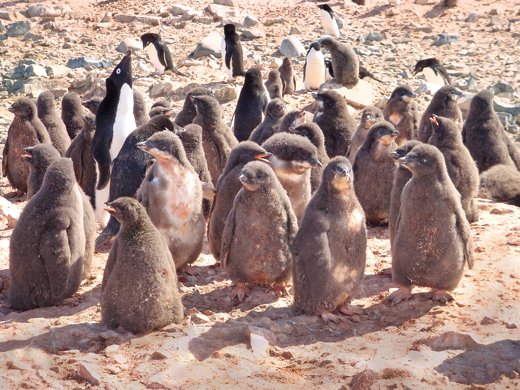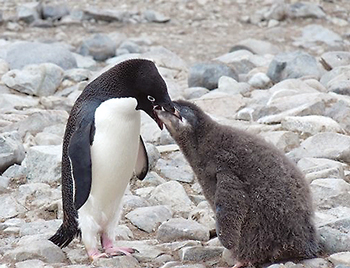
Penguin Chicks
Weight and Climate Change
OUR FACULTY | When Megan Cimino, EOE15PhD, and Matthew Oliver, associate professor of marine science and policy in the College of Earth, Ocean, and Environment, set out to determine the factors that affect the weight of Adélie penguin chicks, they were expecting the results to point to specific food sources.
“The ability of a penguin species to progress is dependent on the adults’ investment in their chicks,” said Oliver, principal investigator on the research project. “Penguins do a remarkable job of finding food for their chicks in the ocean’s dynamic environment, so we thought that the type and size distribution of food sources would impact chick weight.”

Instead, the study revealed that weather and overall atmospheric climate seemed to affect weights the most. In particular, local weather—including high winds, cold temperatures and precipitation, such as rain or humidity— had the largest impact on penguin chick weight variations over time. For example, westerly wind and air temperature can cause a 7-ounce change in average chick weights, as compared to 3.5-ounce change caused by wind speed and precipitation. A 7-ounce decrease in chick weight could be the difference between a surviving and non-surviving chick.
Since 1950, the average annual temperature in the Antarctic Peninsula has increased 2 degrees Celsius on average, and 6 degrees Celsius during winter. As the West Antarctic Peninsula climate warms, the Adélie penguin’s habitat is changing from a dry, polar system to a warmer, sub-polar system with more rain.
Cimino explained that while penguins do build nests, they have no way of building nests that protect the chicks from the elements. This leaves penguin chicks unprotected and exposed while adult penguins are away from the nest. Precipitation, while not considered a key variable, can cause chick plumage to become damp or wet and is generally a major factor in egg and chick mortality and slow growth.
“It’s likely that weather variations are increasing the chicks’ thermoregulatory costs; and when they are cold and wet, they have to expend more energy to keep warm,” she said.
The wind can also affect the marine environment, she continued, mixing up the water column and dispersing the krill, a penguin’s main source of food, which may cause parent penguins to remain at sea for longer periods of time and cause chicks to be fed less frequently.
“This is an interesting study, because it calls into question what happens to an ecosystem when you change climate quickly: Is it just large-scale averages that change the ecosystem or do particular daily interactions also contribute to the change,” Oliver said.
The UD oceanographers reported their findings recently in an article in Marine Ecology Progress Series, a top marine ecology journal. Cimino was the lead author.
She and Oliver returned to Antarctica this winter to continue working with physical oceanographers from the University of Alaska and Rutgers University, through funding from the National Science Foundation. During fieldwork, the researchers tagged Adélie penguins with satellite transmitters to help the research team understand where the penguin parents find food, primarily krill—small shrimp-like crustaceans.
The team also installed radar stations that continuously measure ocean surface currents and used autonomous underwater vehicles (AUVs) called gliders to measure the water temperature and salinity near Palmer Station, as well as the amount of phytoplankton beneath the water’s surface. Combining data from the robots and radar stations will allow the scientists to see if winds, tides or internal waves can affect the stability of the water column.
Connecting the dots between the phytoplankton— microscopic plants—and the krill that feed on them, along with the penguin feeding habits, may help scientists start to paint a picture of what’s happening with the native Antarctic species. “It’s important for us to understand what’s going on, especially as conditions are getting warmer and wetter, because it may give us an idea of what may happen to these penguins in the future,” Cimino said.
ABOUT THE TEAM
Other co-authors on the paper include William Fraser and Donna Patterson-Fraser, from the Polar Oceans Research Group, and Vincent Saba, from NOAA National Marine Fisheries Service. Fraser and Patterson have been collecting data on Adélie penguins since the late 1970s, creating a strong fundamental data set that includes statistics collected over decades, even before rapid warming was observed.
The work reported here is supported in part through funds from the National Marine Fisheries Service, NASA and the National Science Foundation.
Article by Karen B. Roberts, AS90






